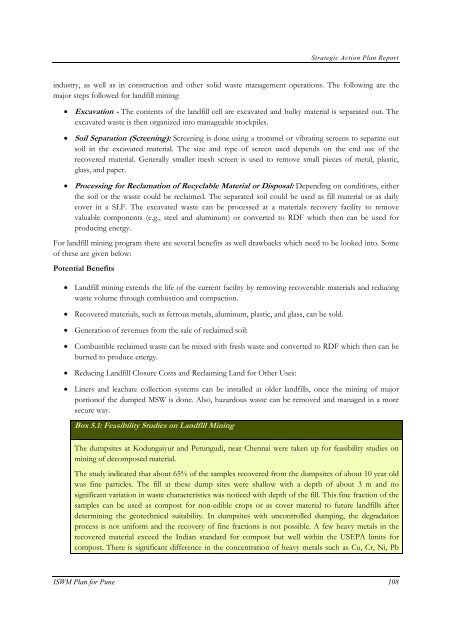Strategic Action Plan - International Environmental Technology Centre
Strategic Action Plan - International Environmental Technology Centre
Strategic Action Plan - International Environmental Technology Centre
Create successful ePaper yourself
Turn your PDF publications into a flip-book with our unique Google optimized e-Paper software.
<strong>Strategic</strong> <strong>Action</strong> <strong>Plan</strong> Report<br />
industry, as well as in construction and other solid waste management operations. The following are the<br />
major steps followed for landfill mining:<br />
• Excavation - The contents of the landfill cell are excavated and bulky material is separated out. The<br />
excavated waste is then organized into manageable stockpiles.<br />
• Soil Separation (Screening): Screening is done using a trommel or vibrating screens to separate out<br />
soil in the excavated material. The size and type of screen used depends on the end use of the<br />
recovered material. Generally smaller mesh screen is used to remove small pieces of metal, plastic,<br />
glass, and paper.<br />
• Processing for Reclamation of Recyclable Material or Disposal: Depending on conditions, either<br />
the soil or the waste could be reclaimed. The separated soil could be used as fill material or as daily<br />
cover in a SLF. The excavated waste can be processed at a materials recovery facility to remove<br />
valuable components (e.g., steel and aluminum) or converted to RDF which then can be used for<br />
producing energy.<br />
For landfill mining program there are several benefits as well drawbacks which need to be looked into. Some<br />
of these are given below:<br />
Potential Benefits<br />
• Landfill mining extends the life of the current facility by removing recoverable materials and reducing<br />
waste volume through combustion and compaction.<br />
• Recovered materials, such as ferrous metals, aluminum, plastic, and glass, can be sold.<br />
• Generation of revenues from the sale of reclaimed soil:<br />
• Combustible reclaimed waste can be mixed with fresh waste and converted to RDF which then can be<br />
burned to produce energy.<br />
• Reducing Landfill Closure Costs and Reclaiming Land for Other Uses:<br />
• Liners and leachate collection systems can be installed at older landfills, once the mining of major<br />
portionof the dumped MSW is done. Also, hazardous waste can be removed and managed in a more<br />
secure way.<br />
Box 5.1: Feasibility Studies on Landfill Mining<br />
The dumpsites at Kodungaiyur and Perungudi, near Chennai were taken up for feasibility studies on<br />
mining of decomposed material.<br />
The study indicated that about 65% of the samples recovered from the dumpsites of about 10 year old<br />
was fine particles. The fill at these dump sites were shallow with a depth of about 3 m and no<br />
significant variation in waste characteristics was noticed with depth of the fill. This fine fraction of the<br />
samples can be used as compost for non-edible crops or as cover material to future landfills after<br />
determining the geotechnical suitability. In dumpsites with uncontrolled dumping, the degradation<br />
process is not uniform and the recovery of fine fractions is not possible. A few heavy metals in the<br />
recovered material exceed the Indian standard for compost but well within the USEPA limits for<br />
compost. There is significant difference in the concentration of heavy metals such as Cu, Cr, Ni, Pb<br />
ISWM <strong>Plan</strong> for Pune 108
















